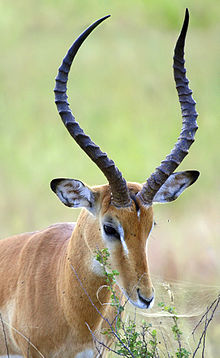
Back ቀንድ Amharic الأسلحة (في الكائنات الحية) Arabic بوینوز (حئیوان) AZB Мөгөҙ Bashkir Rags BAT-SMG Рог Byelorussian Рог BE-X-OLD Badug BEW Рог Bulgarian Corru Corsican

In biology, a weapon is a specialized physical trait that is used by animals to compete with other individuals for resources.[1] Most commonly, the term refers to structures that males use to fight other males off for access to mates.[2] They can also be used to defend resources in intraspecific competition, or to ward off predators. Examples of weapons include horns and antlers, both among the most recognizable weapons, though even within those categories, the structure of the specific weaponry is often unique to the species, with a wide variety of designs observed across many genera.[3]
Many weapons evolve through sexual selection, as they are most often used to fight off competitors for access to mates.[3] A mate is won in battle either by a male chasing off a fellow competitor or killing it, usually leaving the victor as the only option for the female to reproduce with, favoring males with particularly effective weaponry.[4] More broadly, weaponry in animals may consist of any specialized morphology that is present within an organism to aid in its advantage against rivals.[1] Many hypotheses have been produced by researchers to possibly explain the mechanisms behind the evolution of weapons, with studies detailing the intensity, duration, and conclusion of intraspecific combat, as well as analyzing the rapid diversification within species.[5]
Since Darwin's publication The Descent of Man, extensive research has been done on the presence of agonistic behavior and the usage of animal weaponry by different species.[1] Weaponry displays in animals have been found to increase their likelihood of survival in different ways, such as when interacting with other individuals or trying to find another mate, or to defend against predators.[2]
- ^ a b c Palaoro, Alexandre V.; Peixoto, Paulo Enrique Cardoso (2022). "The hidden links between animal weapons, fighting style, and their effect on contest success: a meta-analysis". Biological Reviews. 97 (5): 1948–1966. doi:10.1111/brv.12877. ISSN 1464-7931. PMID 35790073. S2CID 250282536.
- ^ a b Lane, Sarah M (2018-07-19). "What is a weapon?". Integrative and Comparative Biology. 58 (6): 1055–1063. doi:10.1093/icb/icy083. hdl:10026.1/16293. ISSN 1540-7063. PMID 30010939.
- ^ a b Emberts, Zachary; Hwang, Wei Song; Wiens, John J. (2021-01-27). "Weapon performance drives weapon evolution". Proceedings of the Royal Society B: Biological Sciences. 288 (1943): 2020–2898. doi:10.1098/rspb.2020.2898. PMC 7893261. PMID 33499793.
- ^ Krebs, J. R., and Nicholas B. Davies. "Sexual Selection, Sperm Competition and Sexual Conflict." An Introduction to Behavioral Ecology. 4th ed. Oxford: Blackwell Scientific Publications, 2012.
- ^ Emlen, Douglas J. (2008-12-01). "The Evolution of Animal Weapons". Annual Review of Ecology, Evolution, and Systematics. 39 (1): 387–413. doi:10.1146/annurev.ecolsys.39.110707.173502. ISSN 1543-592X.
© MMXXIII Rich X Search. We shall prevail. All rights reserved. Rich X Search